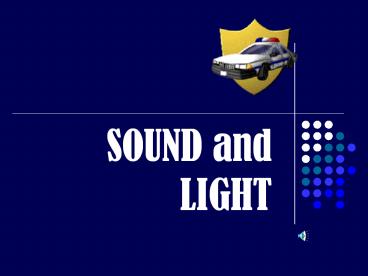SOUND and LIGHT - PowerPoint PPT Presentation
1 / 23
Title:
SOUND and LIGHT
Description:
They are longitudinal so air molecules move parallel to the direction of the wave. ... The amount of energy in a wave. Intensity determines the ... Can diffract ... – PowerPoint PPT presentation
Number of Views:38
Avg rating:3.0/5.0
Title: SOUND and LIGHT
1
SOUND and LIGHT
2
SOUND WAVES
- Remember, they are mechanicalmust have a medium.
- They are longitudinal so air molecules move
parallel to the direction of the wave.
3
Direction of Wave
- Energy travels out in all directions from
vibrating object.
4
Intensity of Sound
- The amount of energy in a wave.
- Intensity determines the amplitude of a wave.
- Intensity relates to the loudness of a sound -
the greater the intensity, the louder the sound.
5
Intensity
- Decibels (dB) - the units of intensity.
- Sounds over 120 dB will cause pain in the ears.
- Ear damage can begin with exposure to sounds as
low as 85 dB.
6
Decibels of other Sounds
- 40quiet conversation
- 60busy street
- 75vacuum cleaner
- 85heavy truck traffic
- 110power tools
- 140singer screaming into microphone
- 155jet engineup close
7
Pitch
- This is how high or low a sound seems.
- A bird makes a high pitch. A lion makes a low
pitch. - Pitch has to do with frequency and amplitude.
8
More on Pitch
- The amount of frequency depends on the amplitude
of the wave. - High pitch high frequency, shorter amplitude
- Low pitch low frequency, larger amplitude
9
Hearing Frequencies
- Humans hear between 20 Hz and 20,000 Hz.
- Ultrasonicfrequencies above 20,000 Hz dogs and
bats can hear ultrasonic - Infrasonicfrequencies below 20 Hz wind,
earthquakes, heavy machinery
10
DOPPLER EFFECT
- An apparent frequency shift due to the relative
motion of an observer and a wave source. - The pitch will seem to change due to the wave
moving.
11
- As wave approaches you, you perceive a higher
pitch. - As wave moves away from you, you perceive a lower
pitch. - http//www.cpo.com/Weblabs/chap2/doppler4.htm
12
(No Transcript)
13
(No Transcript)
14
What is happening here?
15
What Can Sound Do?
- Can reflectsome sounds produce echoes when it
bounces off hard surfaces.
16
- Can interfere
- Destructivemakes sounds quieter
- Constructivemakes sounds louder
17
LIGHT
- Can reflectobeys the Law of Reflection angle
of incidence is equal to the angle of reflection.
- Can reflect in mirrorsupright, same size image
- Can diffract
18
- Can interfere both constructively and
destructively sometimes produces a color
pattern. (Think about bubbles)
19
REFRACTION OF LIGHTPRISMS
- Light slows down when it enters a prism and bends
down when it strikes at this angle. - When light exits the prism, it speeds back up and
bends down again.
20
- When white light enters another medium, the
colors may spread out. Violet end slows down
more than the red end, so it bends more.
21
INDEX OF REFRACTION--Examples
Substance Index of Refraction n Substance Index ofRefraction n
Diamond 2.419 Ethyl Alcohol 1.361
Cubic Zirconia 2.21 Ice 1.309
Glass (flint) 1.66 Water 1.333
Glass (crown) 1.52 Air 1.000
22
LENSES
- Lenses can be convex (converging)
- Used on people with farsightedness (cant see up
close)
23
- Or lenses can be concave (diverging)
- Used on people with nearsightedness (cant see
far away)































